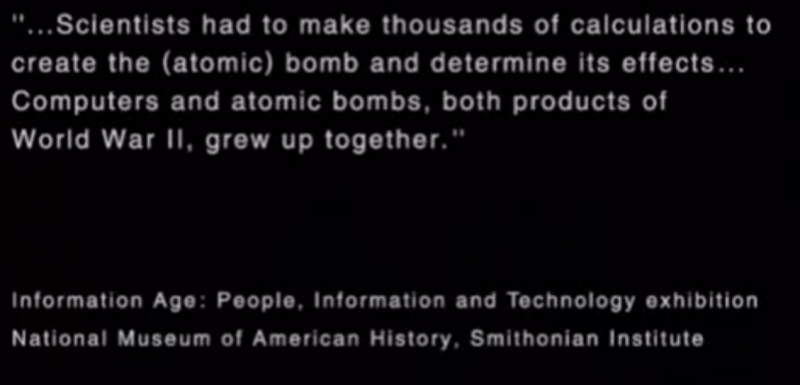Curator's Note
In creating museum exhibits, writing exhibit labels is perhaps the most rewarding and frustrating activity. Working with word counts that high school students would kill for, writing labels becomes an iterative exercise in reduction and carefully parsing words to distill an object or idea and its significance in the clearest and most concise fashion. So it's quite admirable to see an existing museum label reduced even further and yet accomplish this goal effectively in a video game.
In Metal Gear Solid 2: Sons of Liberty, the epigraph above (screenshot taken from video here) is shown before the main story begins and is adapted from an exhibition label to impart the essence of the game's narrative. The exhibition cited, Information Age: People, Information and Technology, was at the Smithsonian Institution National Museum of American History from 1990 until 2006. It covered the development of information and communications technologies and their impact on society starting with the first telegraph line in 1843 up until what was at the time cutting-edge technology such as satellite communications and the internet.
I found myself very curious regarding the particulars of how Kojima and his staff came about this label. As far as I know, the exhibition did not have a virtual component. The project director of the exhibition did not recall giving a tour to a Japanese video game designer and/or his team. Thankful of AdamSpencer87's foresight to upload a video capture from The Document of Metal Gear Solid 2 on YouTube, the team was in Washington DC to shoot real life footage for the ending scene which does not appear to have been incorporated in the final game. It does seem conceivable that in between shots they stopped in the museum for a visit.
It is also worth noting that the museum label, one of the shortest forms of communication, is embedded within one of the longest forms of communication, a video game, particularly a Metal Gear Solid video game known for its long, cinematic narratives. If Kojima was a curator, would he adapt to the limitations most exhibitions place, or would he seek his own path with overarching narratives? Whatever path he would choose, we could be sure we're in for a ride.

Comments
Exhibit Labels
Thank you for writing this. It was a unique perspective about such a small element in what otherwise is an almost excessive game. The game's implementation of this label, that it, as you wrote "impart[s] the essence of the game's narrative" does not appear that completely different from how museum labels frame one's understanding of the exhibited object. It's a very high-minded approach to game design hinting at Kojima's ambition for his games.
Info and condensation
Woah! This piece was so thoughtful despite its tiny subject matter. Way to hone in on something to expand and make it deeply interesting, Drew. I am reminded of the companion application to MGS4, MGS4: The Database. This was a free download that tried to condense all the plot, history, characters, ideas/things in the entire Metal Gear Solid series into single database entries, timelines, relationship charts, etc. Maybe there is some disciplinary overlap between curation and what went into the creation of the database, and, if so, I have to wonder at the feat of condensing this whole series into these small entries. While I doubt Kojima directed this project, the existence of databases like this, and the presentation of the content on the MGS3: Subsistence bonus disc maybe suggests that Kojima believes the exhibition and archive format is something that lives comfortably within video games as is. I think it's clear he finds these information-dense spaces/systems to be of significant value.
Thanks for writing this, Drew!!
MGS2 as Exhibit
Your piece got me thinking about the meta-nature of our comentaries this week. Kojima and his team chose to preface MGS2 with an exhibit label and we, in turn, are creating curatorial commentary for Kojima games as exhibit pieces.
Considering MGS2 in this light, what kind of exhibit is the game itself? The label invites us to approach the game as we would a museum exhibit, if a very modern and interactive one. Does Kojima's exhibit invite a comparison between offshoots of computational technologies: the atomic bomb and the game we are about to play?
Add new comment